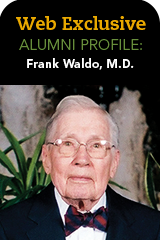Riding Along with First Responders
By Glenny Brock |
Sarah Nafziger, M.D. (center), gives emergency medicine residents a realistic view—and a better understanding—of the challenges of pre-hospital care. |
Though the wail of ambulance sirens can be frightening, there’s something reassuring in the din. Those warning signals let people know that first responders—men and women who have undergone intensive training in emergency medical services (EMS)—are on their way to protect lives in danger.
First responders play a critical role in patient care, yet “EMS is one of the least understood aspects of medicine, even though it’s the one that everyone thinks they know the most about,” says Sarah Nafziger, M.D. ’99. Through UAB’s Office of Emergency Medical Services, which she directs, and UAB’s Emergency Medicine Residency Training (EMRT) program, led by Andrew Edwards, M.D. ’00, Nafziger has educated many of Alabama’s first responders and emergency department physicians—and helped bridge the divide that often separates them.
Ambulance Observation
“Emergency medicine is protocol-driven,” she says. “For example, there are explicit protocols for burn victims, gunshot wounds, and heart attacks.” EMS providers must also decide on the best immediate care for a patient in crisis. Pre-hospital treatment affects not only the level of pain and suffering a patient endures but also the response of the doctors and nurses who receive the patient at the hospital.
“There’s a huge human factor,” Nafziger says. “Emergency medicine is not just about medical knowledge; we have to know how to interface with other physicians, with paramedics, with emergency medical technicians [EMTs], and with the patients themselves.”
The three-year EMRT program teaches residents to think and act fast while always staying conscious of patients’ medical, psychological, and social needs. Residents complete an “observership” with Birmingham Fire and Rescue, riding with ambulance crews responding to 911 calls. They also observe dispatch at the Alabama Trauma Communications Center.
One objective of this firsthand experience is exposing residents to the many challenges first responders face, Nafziger explains. “Medical residents often have unreasonable expectations of paramedics,” she says. “Riding along can give them a sense of the kind of conditions under which paramedics and EMS providers must work. What seems like an unusual or extreme situation may be something that paramedics have already seen three times that day.”
Community Connection
|
Critical Minutes UAB’s Alabama Resuscitation Center is one of 10 sites participating in the Resuscitation Outcomes Consortium (ROC), a clinical research network studying early delivery of interventions for serious trauma and cardiac arrest by EMS teams. Jeffrey Kerby, M.D., Ph.D. (resident ‘95), an associate professor in the UAB section of Trauma, Burns, and Critical Care and an ROC principal investigator, says that determining the most effective resuscitation efforts and applying them in the first minutes after cardiac arrest or serious trauma could improve pre-hospital care for severely ill or injured patients and save lives. |
Another objective is demonstrating how rewarding the work can be, despite—or perhaps because of—its intensity. “In other specialties, people’s ability to pay can affect the kind of care they receive, but we don’t have to deal with those concerns in emergency medicine,” Nafziger says. “I take care of people from all walks of life.
“Everyone who practices emergency medicine has the opportunity to treat the sickest of the sick,” Nafziger adds. “That’s what the field is really about. No one goes into EMS for the money—first responders typically make about half of what nurses make. And they don’t go into it for the status—a lot of times, doing their job requires going into unsafe situations. They have to have a passion for it,” adds Nafziger, who describes herself as an “adrenaline junkie.”
Through her teaching, Nafziger hopes to share that passion. One of her goals is to increase physician involvement with community-based EMS services, such as fire departments and volunteer rescue squads. She serves as EMS medical director for a number of local services, including Trussville Fire and Rescue and Hoover Fire.
“Historically, there has not been a lot of physician involvement in EMS,” Nafziger says. “It has been limited to those who love the field, but I encourage every resident who comes through the EMRT program to find at least one local agency and get involved.
“EMS providers often have been wary of physicians, and physicians can have the same sort of feelings about paramedics, even though they’re working toward common goals,” Nafziger explains. “The big divide happens at the back door of the emergency department. Our programs help bridge that gap, which makes for better communication among health professionals and better care for patients.”
